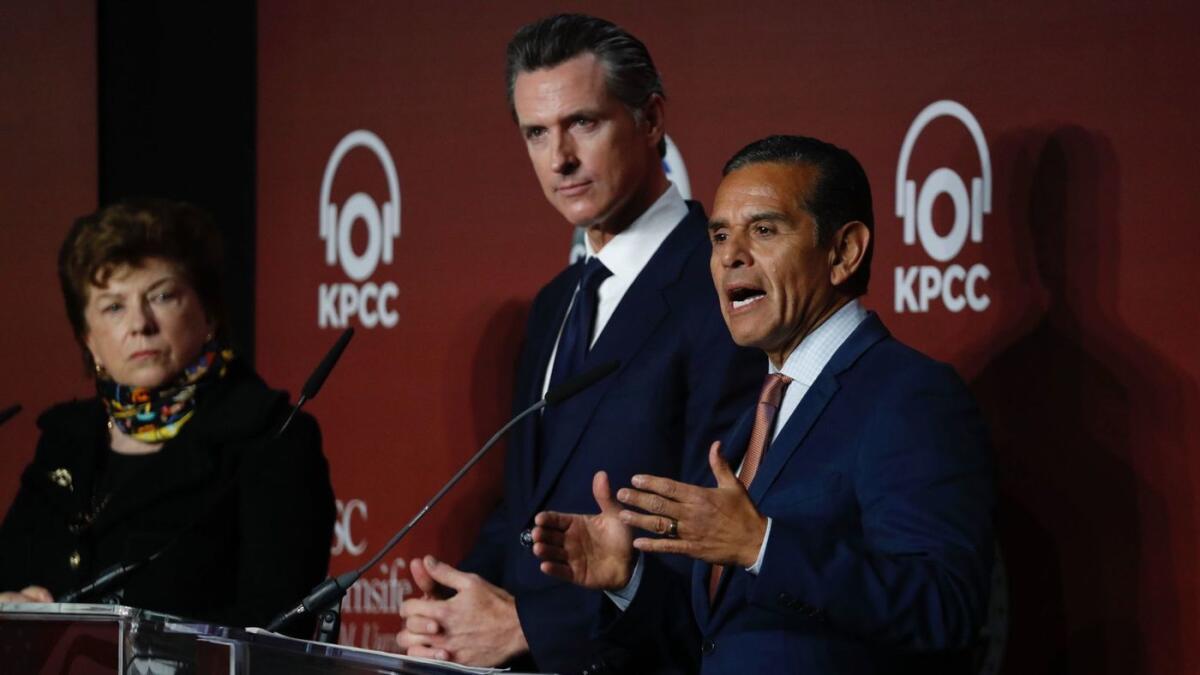Column: Latino voters could make all the difference in California’s narrowing race for governor

- Share via
Reporting from Sacramento — Lt. Gov. Gavin Newsom shouldn’t be called the front-runner anymore in the race for California governor. Former Los Angeles Mayor Antonio Villaraigosa has essentially caught up.
“It’s a virtual toss,” says Mark Baldassare, president and pollster of the nonpartisan Public Policy Institute of California.
Newsom’s once significant lead over fellow Democrat Villaraigosa has slowly eroded and the two are now statistically tied, based on a new PPIC poll of likely voters.
How’d that happen? Latinos are flocking to Villaraigosa, the poll shows. And this could be the year that Latinos actually vote in powerful numbers, inspired by their disdain of President Trump’s rants about illegal immigration.
The candidates’ first goal is to finish among the top two in the June 5 primary. Those two, regardless of party, will advance to the November runoff to decide who succeeds the termed-out Gov. Jerry Brown.
Newsom and Villaraigosa seem headed to the runoff, based on the PPIC survey.
The results: Newsom 23%, Villaraigosa 21%. The margin of error is 4%.
The two leaders were followed at a distance by a large field: Democratic state Treasurer John Chiang, 9%; Republican Assemblyman Travis Allen of Huntington Beach, 8%; Republican businessman John Cox, 7%; Democratic former state schools chief Delaine Eastin, 4%; and Republican former U.S. Rep. Doug Ose of Sacramento, 3%.
There are a lot of undecided voters. Most people have never heard of the candidates other than Newsom and Villaraigosa, or didn’t know enough about them to have an opinion.
Do the math: If there weren’t three Republicans running and splitting the GOP’s gradually declining vote, one might have a fighting chance of making it into the top two.
The field could still change. The candidate filing deadline isn’t until March 9.
A PPIC poll in November also showed upward movement for Villaraigosa. He trailed Newsom then by five percentage points. Since that time, the former L.A. mayor and state Assembly speaker has picked up three points while Newsom has stood still.
A USC Dornsife/Los Angeles Times poll in October found Newsom leading Villaraigosa by 10 percentage points.
A recent online poll by the USC Rossier School of Education showed Newsom with a 15-point lead over Villaraigosa. That survey identified Villaraigosa as a businessman, not a former mayor.
Latinos are the story of the PPIC poll.
Villaraigosa led Newsom among Latinos by 35 points. Among whites, Newsom led by 15. A whopping 67% of Latinos had a favorable opinion of Villaraigosa; 37% did of Newsom. That translated into a 40% favorable rating for both candidates among all likely voters.
State Senate leader Kevin de León (D-Los Angeles) wasn’t benefitting nearly as much from Latinos in his uphill race against U.S. Sen. Dianne Feinstein. She was leading 46% to 17%. And Latinos supported her 47% to 29%.
Villaraigosa would be the first Latino to be elected California governor. One Latino, Romualdo Pacheco, was chief executive for a few months in 1875 after ascending from lieutenant governor when the governor, Newton Booth, was elected to the U.S. Senate.
Villaraigosa also would be the first former L.A. mayor to be elected governor. In the poll, Villaraigosa had an 18-point lead in Los Angeles County. But the runner-up was Chiang, one point ahead of Newsom. Newsom, a former San Francisco mayor, was running far ahead of Villaraigosa in the Bay Area by 33 points.
California governor’s race is likely to be decided in Los Angeles County »
Bay Area voters have been turning out for elections more reliably than Angelenos. And Latinos, regardless of their growing population numbers, have basically been no-shows at the ballot box. Villaraigosa’s fate depends on his ability to turn out L.A. and Latino voters.
“If in any year Latinos are going to vote, this is the year,” says Roger Salazar, a Democratic political consultant who’s not involved in the gubernatorial campaign.
Coverage of California politics »
“I’d really like before I get done with this [career] to see Latinos vote in the same percentages as their population. If we can’t do it in a year like this, it might never happen.”
Mike Madrid is a longtime Republican consultant who has practically given up on the GOP and is working for Villaraigosa. He thinks there could be a large Latino turnout and cites four reasons for his optimism.
First, Trump has particularly angered Latinos.
“The [Latino] giant went to sleep for 20 years and woke up stronger in 2016” when Trump was elected, Madrid says.
There was evidence of it in November during a Virginia gubernatorial election, he adds. Latinos had an unusually good turnout.
The PPIC poll found that 82% of Latino voters disapprove of Trump’s job performance. Among all voters, 67% do.
Asked which is the most important issue for the governor and Legislature to address, the No. 1 answer by far was immigration, especially among Latinos. “Sanctuary state” policies “to protect the legal rights of undocumented immigrants” were favored by 80% of Latinos, and 58% of all voters.
Second, Madrid says, Villaraigosa has always benefited from good Latino turnouts in his election races.
Third, there’ll be major Latino candidates running for five statewide offices this year. Each presumably will attract Latino voters.
Fourth, Madrid adds, there are a record number of Latino candidates running in local elections. And those contests have been consolidated with the state elections.
“There’s a confluence of events,” Madrid says. “Any one of them could have a significant impact.”
Trump already has had an impact by riling Latinos and boosting Villaraigosa.
Follow @LATimesSkelton on Twitter
More to Read
Get the L.A. Times Politics newsletter
Deeply reported insights into legislation, politics and policy from Sacramento, Washington and beyond. In your inbox twice per week.
You may occasionally receive promotional content from the Los Angeles Times.











